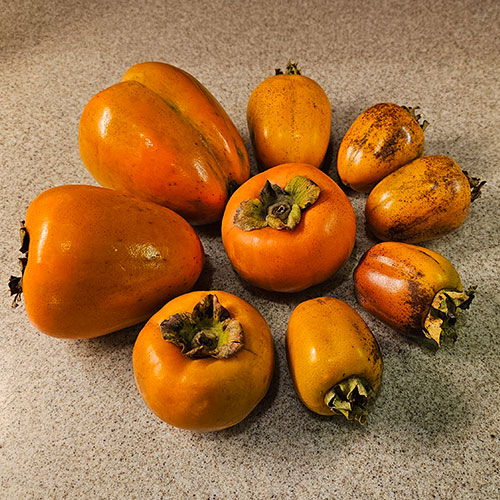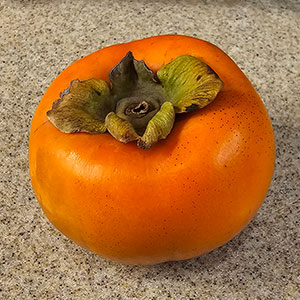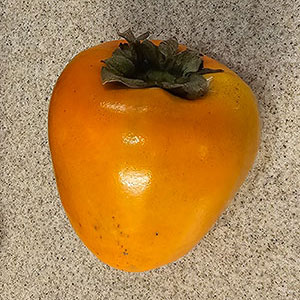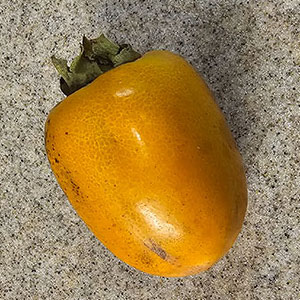Persimmons in the Southeast United States: Native Flavor, Southern Charm

The Southeast United States—with its warm summers, mild winters, and rich biodiversity—is a fantastic region for growing persimmons. Whether you’re in Georgia, the Carolinas, Florida, Alabama, Mississippi, or Tennessee, persimmons can thrive in your backyard, offering sweet fruit, minimal care, and natural beauty.
A history of the persimmon
Japanese persimmons (Diospyros kaki) have a rich history that spans over a thousand years. Originating in China during the Tang Dynasty (618-907 AD). They made their way to Japan in the 7th century via China and Korea. In Japan, they became deeply intertwined with the country’s culture, symbolizing autumn and seasonal change. Over time, Japanese horticulturists selectively bred and developed various cultivars, such as the popular Fuyu and Hachiya varieties. Japanese persimmons have since transcended Asia, and they are now grown in many parts of the world, notably the United States. Known for their sweet, versatile nature, Japanese persimmons are a culinary delight. They are also a testament to their enduring cultural and historical significance, bridging the past and present in a single, delicious fruit.
Native American persimmons are common in the wild and in traditional Southern gardens. Asian persimmons are becoming increasingly popular for their large, sweet fruits and reliable productivity. They were introduced to the U.S. in the 1800s and are particularly suited to Southeastern states with mild winters and long growing seasons. Especially in the Deep South and coastal areas.
 The Fuyu persimmon
The Fuyu persimmon
Known for its unique and delightful character, it is a beloved fruit in the world of persimmons. This Japanese variety stands out with its flat, tomato-like shape and vibrant orange color. Fuyu persimmons are enjoyed for their versatility. They can be savored at various stages of ripeness. When firm, they offer a sweet, crisp texture with hints of honey, making them perfect for snacking, slicing into salads, or incorporating into appetizers. As they ripen, their flavor becomes even more delectable, achieving a succulent, custard-like consistency that’s ideal for desserts, purees, and baking. Loved for their mild, approachable taste and alluring appearance, Fuyu persimmons continue to be a culinary favorite, adding a touch of sweetness and elegance to a wide range of dishes.
- Non-astringent, can be eaten while still firm
- Crisp texture, sweet flavor
- Flat and round shape
- Ideal for fresh eating and salads
- Self-pollinating
 The Hachiya persimmon
The Hachiya persimmon
A unique and distinctive fruit that stands out in the world of persimmons. With its elongated, acorn-shaped form and vivid orange hue, it boasts a visually striking appearance. What sets the Hachiya apart is its flavor and texture, which undergo a remarkable transformation as it ripens. When fully mature, this persimmon becomes incredibly sweet and develops a luscious, custard-like consistency. However, it’s important to note that when not fully ripe, the Hachiya can be astringent and mouth-puckering due to high levels of tannins. To enjoy it at its best, the Hachiya should be consumed when it has turned soft and jelly-like, making it a superb choice for creating delectable desserts, puddings, and purees. Its unique taste and versatile culinary applications make the Hachiya persimmon a prized ingredient in many sweet and savory dishes.
- Astringent when firm; must be fully soft before eating
- Very sweet, custard-like flesh when ripe
- Heart-shaped
- Great for baking, purees, and preserves
- Self-pollinating
 The Saijo persimmon
The Saijo persimmon
Often hailed as the “King of Persimmons,” is a remarkable fruit celebrated for its exquisite flavor and elegant appearance. Originating from Japan, this variety is a small to medium-sized persimmon with a smooth, reddish-orange skin. What truly distinguishes the Saijo persimmon is its unparalleled sweetness and complexity of flavor. It offers a harmonious blend of honeyed, tropical notes, often described as having hints of apricot, brown sugar, and spice. The flesh is smooth and succulent, and when fully ripe, it practically melts in your mouth. Saijo persimmons are a culinary treasure, perfect for enjoying fresh, adding to salads, or elevating desserts and baked goods with their delectable sweetness and distinctive character. Whether savored alone or incorporated into various culinary creations, the Saijo persimmon is a testament to the delicious diversity within the world of persimmons.
- Smaller, astringent fruit that ripens early
- Excellent cold-hardiness (down to Zone 6)
- Incredibly sweet when ripe
- Often called one of the best-tasting persimmons
Growing your own persimmons
Asian persimmons thrive best in USDA Zones 7–10. Making them a suitable choice for much of the Southeast. Some varieties may struggle with cold sensitivity in higher elevations like the mountain regions of North Carolina or Tennessee. These trees are relatively compact, typically growing to 10–20 feet, which makes them easy to maintain. However, they can experience heavy fruit drop, a problem that can be mitigated by thinning young fruit to reduce the burden on the tree.
For optimal growth in the Southeast, plant persimmon trees in the fall or early spring when they are dormant, using either bare-root or container-grown trees. Select a site with full sun, providing 6–8 or more hours of daily light, and ensure the soil is well-drained, as persimmons do not tolerate “wet feet.” Adding mulch around the base helps retain moisture and minimizes weed competition. Water regularly during the first 1–2 years to establish strong roots, after which most persimmons, especially native types, become drought-tolerant. Fertilization should be minimal—excess nitrogen can hinder fruiting—so a light application of compost or balanced fertilizer in spring is usually sufficient.
Eating persimmons
Persimmon trees offer significant benefits to local ecosystems, attracting bees and other pollinators with their spring flowers and providing fall fruit that deer, birds, and small mammals enjoy. Their shade and vibrant fall color also make them an excellent addition to native plant gardens and food forests. When it comes to eating, persimmons—whether from wild American trees or cultivated Asian varieties—offer rich flavor and nutrients. The Fuyu type can be sliced and eaten raw like an apple or added to salads, while the Hachiya should be fully soft before being used in puddings, muffins, or smoothies. American persimmons are best when ripened on the tree or picked when jelly-soft, ideal for traditional Southern dishes like persimmon pudding or cookies. For storage, keep ripe persimmons in the fridge for up to a week, freeze the pulp for baking or smoothies, or dry slices into chewy, candy-like snacks.
Click here to read about other fruit trees that are also goat friendly.


